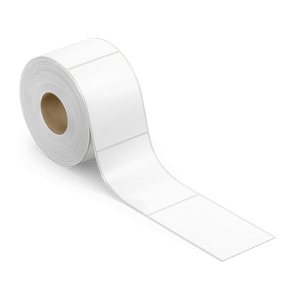Top 5 Applications for Direct Thermal Labels in Warehousing & Retail

Direct thermal labels are used daily in warehousing and retail to print shipping labels, shelf tags, inventory barcodes, and return slips—without needing ink or ribbons. They're fast, cost-efficient, and especially useful for short-term labeling.
Popular formats like 4x6 thermal labels on rolls are standard for shipping and inventory tasks, making them a go-to in high-volume operations.
1. Shipping and Logistics
In fast-moving shipping and logistics operations, 4x6 direct thermal labels are the industry standard. Major carriers like UPS, FedEx, and USPS prefer this size for its ample space to display shipping details, barcodes, and tracking numbers clearly. The direct thermal printing process ensures quick production of labels, streamlining the shipping process and reducing delays.
Tip: Ensure your labels are compatible with your thermal printer model to avoid printing issues.
![]()
2. Inventory Management
Efficient inventory management is crucial in warehousing and retail. Direct thermal roll labels are commonly used for barcode labeling, shelf organization, and product tracking. Their smudge-free, high-resolution printing ensures that barcode scanners can read labels accurately, preventing stock discrepancies and improving workflow efficiency.
Example: A retail store implementing direct thermal labels for inventory saw a 30% reduction in stock discrepancies within the first quarter.
3. Retail Pricing and Shelf Labeling
Retail environments require frequent price updates and promotions. Direct thermal labels allow for quick printing of price tags and shelf labels, facilitating dynamic pricing strategies. Their ease of use and quick printing capabilities enable staff to update pricing information swiftly, enhancing customer experience.
Tip: Use top-coated direct thermal labels to prevent fading under store lighting.

4. Product Identification
Product identification is vital for both customer information and internal tracking. Direct thermal labels provide clear, legible prints for product names, SKUs, and barcodes. Their quick printing process aids in labeling products efficiently, ensuring accurate information is always available.
Example: A warehouse reported a 25% increase in picking accuracy after switching to direct thermal labels for product identification.
5. Return Merchandise Authorization (RMA) Processes
Handling returns efficiently is essential in retail. Direct thermal labels are used to generate RMA labels quickly, facilitating the return process. Their clarity ensures that returned items are correctly identified and processed, improving customer satisfaction and operational efficiency.
Tip: Implementing direct thermal labels in the RMA process can reduce return processing time by up to 40%.
Getting the Most Out of Direct Thermal Labels
Using direct thermal labels effectively isn’t just about loading a roll and hitting print. There’s a lot of value to be gained from setting things up smartly—and a few simple tweaks can improve performance, reduce waste, and save time.
Choose the Right Material for the Job
Not all direct thermal labels are the same. Some are designed for quick, low-cost jobs. Others are coated for durability and higher contrast.
Tip:
If your labels will be exposed to friction (like bins, totes, or rubbing during transport), opt for top-coated material. It resists fading and keeps barcodes sharp.
Real-world insight:
A 3PL warehouse that switched to top-coated 4x6 direct thermal labels reduced scan errors by 18%—simply by preventing smudges and minor abrasions on high-touch surfaces.
Store Labels Like They Matter—Because They Do
Even the best labels can fail if they’re stored the wrong way. Since direct thermal material reacts to heat, it’s sensitive long before you ever print on it.
Do this:
- Store unused labels in a cool, dry, shaded space (ideal: below 77°F)
- Keep them sealed and upright—moisture and compression can warp edges
- Avoid storing rolls near heat sources, windows, or equipment that generates warmth
Example:
One retail distribution center saw fewer printer jams and misalignments after moving rolls out of direct sunlight and into covered bins with shelf liners.
Match the Label to the Environment
- Quick use (less than 6 months)? Go with economy-grade uncoated paper.
- High-humidity or cold storage? Use labels with a freezer-compatible adhesive.
- Labels exposed to oil, light, or friction? Consider coated or premium stock.
Use case:
A food distributor began using freezer-rated direct thermal labels for their cold chain shipments and saw fewer instances of labels lifting or falling off after condensation exposure.
Fine-Tune Your Thermal Printer Setup
Getting crisp, consistent prints is less about brand and more about setup.
Helpful settings to check:
- Heat/Darkness settings – Too high causes fading or edge bleed; too low = faint print
- Calibration – Helps prevent skipping or offset printing
- Maintenance – Clean printheads regularly with alcohol wipes, especially in dusty or busy warehouse settings
Tip:
Run a test print every time you switch roll sizes or label types. It only takes a second and can prevent a full batch from being wasted.
Need Labels That Can Keep Up With Your Workflow?
If you're managing a warehouse, stocking shelves, or shipping daily orders, the right labels make a difference. Whether you need something fast, reliable, or just easy to manage, we can help you find the best fit. Take a look at our options for direct thermal labels and get in touch if you need a hand sorting out what works best for your setup.
FAQs
What are direct thermal labels?
Labels that use heat-sensitive material to produce print—no ink or ribbon required. Ideal for short-term uses like shipping, inventory, or retail tags.
Why are 4x6 direct thermal labels so popular?
They’re the standard size for shipping labels with UPS, FedEx, and USPS, offering plenty of space for addresses, barcodes, and tracking info.
How long do direct thermal labels last?
They’re made for short- to mid-term use. Exposure to sunlight, heat, or chemicals can speed up fading, so they’re best for labels needed within 6 months.
Can I use direct thermal labels in the freezer?
Yes—just make sure you’re using labels with a freezer-grade adhesive to avoid peeling or lifting.
Are direct thermal roll labels compatible with my printer?
Most direct thermal printers (Zebra, Dymo, Rollo, etc.) support standard roll formats. Always check size and core compatibility before ordering.
Do I need a special printer for direct thermal labels?
Yes. Direct thermal printers apply heat directly to the label surface. If you're unsure what you have, check the specs—it will list "direct thermal" if it's supported.
What’s the difference between direct thermal and thermal transfer?
Direct thermal uses heat-sensitive labels only. Thermal transfer uses a ribbon and is better for long-term or outdoor applications.










